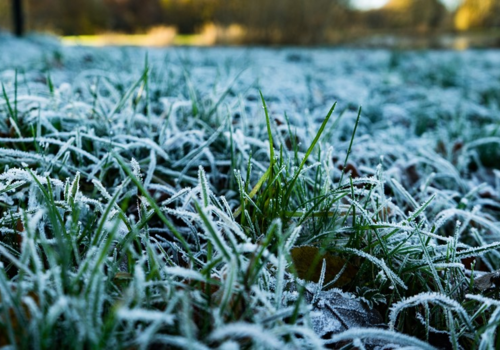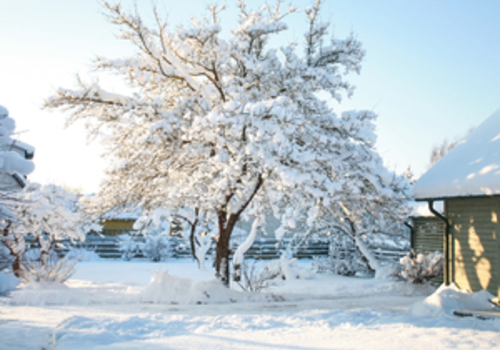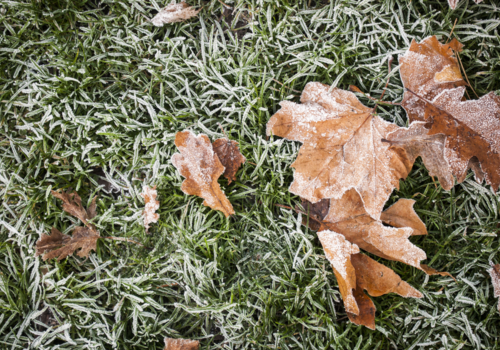
December is a month of cold weather and quite often snow. With the short days and long nights, there are less things that you can do to take care of your lawn during this time.
This lawn care diary instalment provides advice on what you should be doing in December if you want to prepare for the new year and enjoy a green lawn in spring!
What should I do to my lawn in December?
Here's your December lawn care 'to do' list:
- Collect leaves and other debris regularly.
- Don’t walk on the grass unless necessary, especially after snow or frost.
- Aerate and reduce shady areas to help control moss.
- Only cut the grass or fertilise if it’s very mild & absolutely necessary.
- Put your feet up, you deserve a break after maintaining a healthy lawn all year!
Can you still cut grass in December?
Technically, it is still ok to cut your grass in December but we wouldn’t recommend it. It's unlikely to be required in the UK anyway, but if the weather is warm enough for the grass to grow then you can get your mower out to keep it looking neat and tidy.
The problem with cutting grass in December is that mowing it too short could damage it. When daylight is limited, your grass needs to stay long enough to absorb enough sunlight. So only get the mower out if absolutely necessary and set it to the highest setting.
Never mow your lawn in winter when the ground is frosty and the grass has turned brown. The blades of your mower will damage the roots when they get too close to them so it's best avoided at this time of year. Anything below 4 degrees celsius is too cold for mowing, but grass growth is slow in low temperatures too, so it will likely be too short to cut.
Fertilising Your Lawn in Winter
A winter lawn fertiliser can be used to keep your lawn looking green and healthy. However, we recommend you apply your last lawn feed of the year in November.
During the depths of winter, a lawn needs less fertiliser as it is taking its 'downtime’. Your lawns aren't under constant pressure because the grass blades have stopped growing. If the grass is dormant, you could just be giving the weeds a feed which isn't a good idea!
What should I feed my lawn in December?
If December is particularly mild and your lawn is in need of nutrients to help it withstand the winter you could still fertilise, but in general, we'd suggest you wait until the spring.
Autumn and winter lawn fertilisers are available to provide your lawn with the nutrients they need at times of slow growth. It's crucial to select a suitable fertiliser to apply during the winter months.
Autumn and winter lawn feed contains nitrogen, phosphorus and potassium (NPK) which are important fertiliser nutrients for the lawn in winter. The NPK balance is different depending on the season as plants need more of certain nutrients at different times of the year. In general, a higher proportion of phosphorus should be present in fertilisers for winter lawns for healthy root growth. In addition to making up for the lack of sunlight in winter, fertilising your lawn with a concentrated mix rich in iron and magnesium will help prevent disease.
How cold is too cold to fertilise the lawn?
Don't fertilise your lawn if the temperature drops below freezing or the ground is frozen. The roots won't be active if the soil is completely frozen and they won't be able to absorb the nutrients. All your hard work will be fruitless!
Scarifying & Aerating
At this time of year, avoid scarifying your lawn. It will not be able to recover from such harsh treatment. Whilst the lawn is in a dormant state, it won't be able to grow back quickly enough and could end up leaving bald patches in your lawn that will require overseeding with a suitable grass seed later down the line. Don't scarify in December - wait till Spring!
Aeration, on the other hand, is useful for compaction drainage and allowing a better flow of air and nutrients around the root system.
To aerate your lawn in December you should go for a light approach. Use a garden fork rather than a hollow tine aerator. This will help to break up the compacted soil and allow air and water to flow more easily through it. Exposing the lawn to large aeration holes could mean it freezes more easily in cold conditions.
Create small diagonal rows in the grass with the fork, ease back to create holes. Repeat this process until the whole area has been aerated. Repeat this treatment as required in any especially compact or waterlogged areas.
Fallen Leaves
Make sure you collect fallen leaves regularly over the winter months. If you leave them on the lawn they will block out light, rot and cause damage.
Collecting leaves will replace mowing as a regular activity. You should rake leaves off the lawn gently so you don't cause any damage to the grass.
Frost & Snow
In the UK, it's quite typical to have frost and snow in December, January and February. A heavy snowfall is a challenge for a lawn as it completely blocks out the light. Frost and snow will also leave each blade of grass very brittle and prone to breaking. You'll need to prepare your garden for this to prevent damage.
Removing leaves is a great start, as is keeping off the grass as much as possible. You should also take steps to make sure your garden is sheltered from the wind and reduce areas of shade. This is beneficial because it will stop the frost and snow from lingering.
In heavy snow, remember not to clear your path or driveway and pile the snow onto your lawn. Such a mass of snow will take longer to thaw and could cause damage and lawn disease.
Sometimes, you can't avoid heavy frosts or snowfalls. If it does happen to fall on your lawn, then you'll need to focus on recovery in spring.
Winter Lawn Care Tips
- Pests: Worms are a sign of healthy soil so those annoying worm casts are actually a good sign! Unfortunately it's difficult to brush away worm casts in damp and cold conditions. The best defence you have is to keep on top of the leaf collection. This helps to keep matter and debris away from the surface, which helps worms stay deeper underground rather than on the surface of lawns.
- Lawn disease: In December, the most common lawn diseases are fusarium and snow mould. Fusarium is a common fungus that grows in wet areas, and can be avoided by not watering lawns during cold periods. Snow mould is also caused by an airborne fungus, and your lawn may suffer after a prolonged compacted snow cover. If your lawn suffers from either of these during winter, you'll need to consider a recovery plan in the spring.
- Moss: Moss can be an issue during the winter and a serious moss problem will hold down the growth of grass in spring. Moss likes damp areas and will grow in shaded places. Try to reduce shady areas and aerate to help with drainage.
- Seed: Lawn seed won’t grow at this time of year, but you could consider dormant seeding. Sow grass seed if you have bare patches in your lawn and it will germinate in the spring.
We hope that we have been able to provide some helpful advice for those of you looking after the grass in December. That completes your lawn care diary for this year, so put your feet up, down your gardening tools and get ready for lawn care in January! Make sure you visit every month for spring, summer, autumn and winter lawn care tips and advice.


